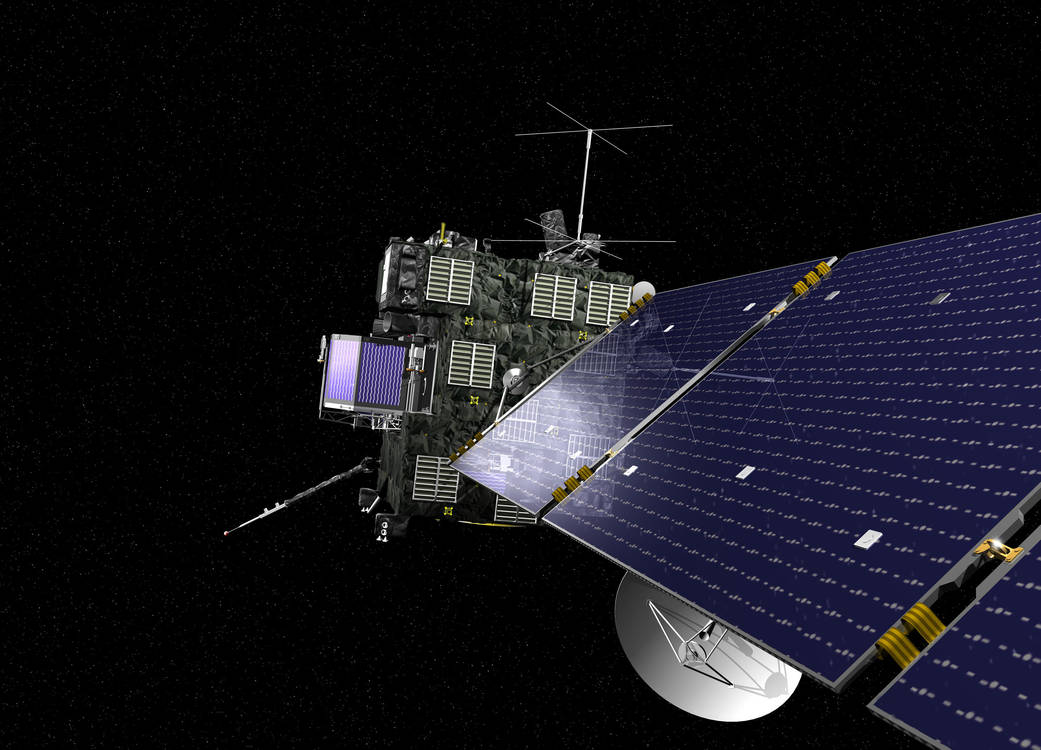
An artist’s view of Rosetta, the European Space Agency’s cometary probe with NASA contributions. The spacecraft is covered with dark thermal insulation in order to retain its warmth while venturing into the coldness of the outer solar system, beyond Mars orbit.
NASA’s contribution includes three of the orbiter’s instruments (the Microwave Instrument for Rosetta Orbiter, the Ion and Electron Sensor and an ultraviolet spectrometer called Alice). NASA is also providing part of the electronics package for an instrument called the Double Focusing Mass Spectrometer, which is part of the Swiss-built Rosetta Orbiter Spectrometer for Ion and Neutral Analysis instrument. NASA is also providing U.S. science investigators for selected non-U.S. instruments and is involved in seven of the mission’s 25 instruments. NASA’s Deep Space Network provides support for ESA’s Ground Station Network for spacecraft tracking and navigation.
Selected in November 1993 as a cornerstone mission of ESA’s long-term science program, the Rosetta probe was launched by an Ariane 5 on March 2, 2004, on an 11-year journey to the comet 67P/Churyumov-Gerasimenko.
Built by EADS Astrium, the Rosetta probe consists of a 6,757-pound (3,065-kilogram) spacecraft (3,479-pound, or 1,578-kilogram dry mass) designed to enter orbit around the comet’s nucleus in August 2014. Its route has included a series of gravity assist maneuvers to gain enough orbital energy, with three swing-bys at Earth (March 2005, November 2007 and November 2009) and one at Mars (February 2007). En route to the comet, the probe flew by the asteroids 2867 Steins (September 2008) and 21 Lutetia (July 2010).
The spacecraft carries 11 science instruments to probe the comet’s nucleus and map its surface in fine detail. It will also land a package of instruments (the Philae Lander) to study some of the most primitive, unprocessed material in the solar system. The mission will provide clues to the physical and chemical processes at work during the formation of planets, beginning 4.6 billion years ago.
Rosetta is a mission of the European Space Agency, Paris, with contributions from its member states and NASA. Rosetta’s Philae lander is provided by a consortium led by the German Aerospace Center, the Max Planck Institute for Solar System Research, the French National Space Agency and the Italian Space Agency. NASA’s Jet Propulsion Laboratory, Pasadena, Calif., manages the U.S. contribution to the Rosetta mission for NASA’s Science Mission Directorate in Washington. The Microwave Instrument for the Rosetta Orbiter was built at JPL and JPL is home to its principal investigator, Samuel Gulkis. The Southwest Research Institute, San Antonio, developed the Rosetta orbiter’s Ion and Electron Sensor (IES) and is home to its principal investigator, James Burch. The Southwest Research Institute, Boulder, Colo., developed the Alice instrument and is home to its principal investigator, Alan Stern.
More information about Rosetta is available online at: www.esa.int/rosetta and
Image Credit: ESA


























